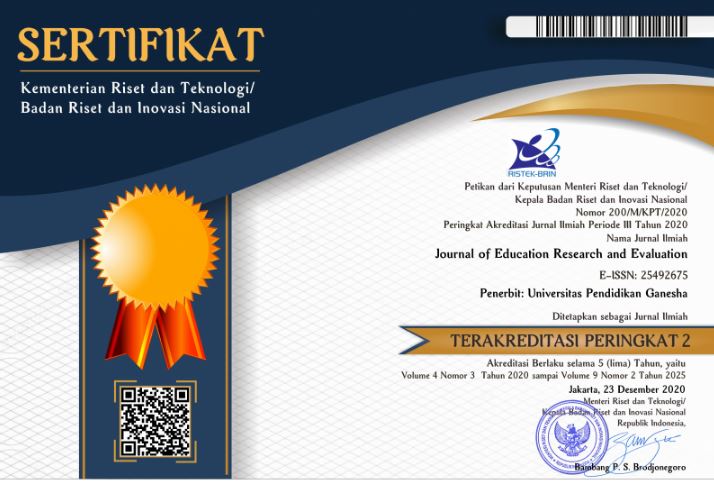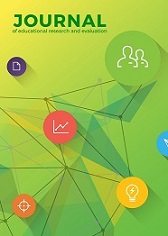Genially Interactive Media: Improving Learning Outcomes of Indonesian Cultural Wealth
DOI:
https://doi.org/10.23887/jere.v8i2.77004Keywords:
Genially, Interactive Media, Learning OutcomesAbstract
Education in Indonesia has shown progress in the last few decades. However, the education system in Indonesia still needs to overcome several challenges, especially in the context of teaching Natural and Social Sciences in Elementary Schools. This research aims to develop Genetically-based interactive media on Indonesian Cultural Wealth material in Natural and Social Sciences Subjects. This type of research is development research using the ADDIE model. The research subjects are learning materials experts and learning media experts. The test subjects were 19 class IV students and teachers. Data collection methods include observation, questionnaires, documentation, and tests. The data collection instrument uses a questionnaire sheet. Data analysis techniques use qualitative and quantitative descriptive analysis. N-gain is used to test media effectiveness. The validity test results show that genetically interactive media is very suitable for use. The use of this media also significantly improves student learning outcomes; student responses to the use of this media are also positive. Thus, Generative interactive media is effective and suitable for learning natural and social sciences in fourth-grade elementary school.
References
Adam. (2023). Pengaruh Media Pembelajaran Audio Visual Terhadap Minat Belajar Siswa Sekolah Dasar. Journal of Contemporary Issue in Elementary Education, 1(1), 29–37. https://doi.org/10.33830/jciee.v1i1.5027. DOI: https://doi.org/10.33830/jciee.v1i1.5027
Afifah. (2022). Pengembangan media pembelajaran interaktif pada pembelajaran bahasa indonesia kelas III Sekolah Dasar. Jurnal Kiprah Pendidikan, 1(1), 33–42. https://doi.org/10.33578/kpd.v1i1.24. DOI: https://doi.org/10.33578/kpd.v1i1.24
Alfatonah. (2023). Kesulitan Belajar Siswa pada Mata Pelajaran IPAS Kurikulum Merdeka Kelas IV. Jurnal Basicedu, 7(6), 3397–3405. https://doi.org/10.31004/basicedu.v7i6.6372. DOI: https://doi.org/10.31004/basicedu.v7i6.6372
Asela. (2020). Peran Media Interaktif Dalam Pembelajaran PAI Bagi Gaya Belajar Siswa Visual. Jurnal Inovasi Penelitian, 1(7), 1297–1304. https://doi.org/10.47492/jip.v1i7.242.
Batubara. (2020). Penggunaan video tutorial untuk mendukung pembelajaran daring di masa pandemi virus Corona. Muallimuna: Jurnal Madrasah Ibtidaiyah, 5(2), 74–84. https://doi.org/10. 31602/muallimuna.v5i2.2950. DOI: https://doi.org/10.31602/muallimuna.v5i2.2950
Cahyadi. (2019). Pengembangan bahan ajar berbasis ADDIE model. Halaqa: Islamic Education Journal, 3(1), 35–42. https://doi.org/10.21070/halaqa.v3i1.2124. DOI: https://doi.org/10.21070/halaqa.v3i1.2124
Churiyah. (2023). Project Based Learning Interactive E-Book: A Solution to Self Regulated Learning and Student Learning Outcomes. BISTIC Business Innovation Sustainability and Technology International Conference (BISTIC 2023, 132–142. https://doi.org/10.2991/978-94-6463-302-3_17. DOI: https://doi.org/10.2991/978-94-6463-302-3_17
Damayanti, P. A., & Qohar, A. (2019). Pengembangan Media Pembelajaran Matematika Interaktif Berbasis Powerpoint pada Materi Kerucut. Kreano, Jurnal Matematika Kreatif-Inovatif, 10(2), 119–124. https://doi.org/10.15294/kreano.v10i2.16814. DOI: https://doi.org/10.15294/kreano.v10i2.16814
Deliany. (2019). Penerapan multimedia interaktif untuk meningkatkan pemahaman konsep IPA peserta didik di sekolah dasar. Educare, 90–97. https://doi.org/10.36555/educare.v17i2.247.
Djamas. (2021). Development of interactive multimedia learning materials for improving critical thinking skills. In Research anthology on developing critical thinking skills in students (bll 507–525). https://doi.org/10.4018/IJICTE.2018100105. DOI: https://doi.org/10.4018/978-1-7998-3022-1.ch026
Engerman. (2021). The shift to digital: designing for learning from a culturally relevant interactive media perspective. Educational Technology Research and Development, 69, 301–305. https://doi.org/10.1007/s11423-020-09889-9. DOI: https://doi.org/10.1007/s11423-020-09889-9
Enstein. (2022a). Pengembangan media pembelajaran game edukasi bilangan pangkat dan akar menggunakan Genially. Jurnal Jendela Pendidikan, 2(01), 101–109. https://doi.org/10.57008/jjp.v2i01.150.
Enstein. (2022b). Pengembangan Media Pembelajaran Game Edukasi Bilangan Pangkat dan Akar menggunakan Genially. Jurnal Jendela Pendidikan, 2(01), 101–109. https://doi.org/10.57008/jjp.v2i01.150. DOI: https://doi.org/10.57008/jjp.v2i01.150
Fatma. (2019). Pengaruh penggunaan media pembelajaran berbasis android terhadap kemampuan pemecahan masalah kimia. Jurnal Inovasi Pendidikan IPA, 5(2), 229–236. https://doi.org/10.21831/jipi.v5i2.26035. DOI: https://doi.org/10.21831/jipi.v5i2.26035
Gulo. (2023). Guru dan Peserta Didik: Evaluasi Diagnostik dalam Penerapan Metode Ceramah. Jubah Raja: Jurnal Bahasa, Sastra, Dan Pengajaran, 2(1), 1–7. https://doi.org/10.30734/jr.v2i2.3224. DOI: https://doi.org/10.25078/ds.v2i1.865
Heliawati. (2022). Articulate Storyline 3 multimedia based on gamification to improve critical thinking skills and self-regulated learning. International Journal of Evaluation and Research in Education, 11(3), 1435–1444. https://doi.org/10.11591/ijere.v11i3.22168. DOI: https://doi.org/10.11591/ijere.v11i3.22168
Hotimah, H., & Muhtadi, A. (2018). Pengembangan multimedia pembelajaran interaktif IPA untuk meningkatkan pemahaman siswa pada materi Mikroorganisme SMP. Jurnal Inovasi Teknologi Pendidikan, 4(2), 201–213. https://doi.org/10.21831/jitp.v4i2.15047. DOI: https://doi.org/10.21831/jitp.v4i2.15047
Ida Nur Aini, Widyawati, Z. H., Shofiana, A. M., Wulandari, F. N., Nabilah, E. R., & Hilyana, F. S. (2024). Analisis Faktor-Faktor Kesulitan Belajar Ipas Pada Peserta Didik Kelas V Sekolah Dasar. Didaktik: Jurnal Ilmiah PGSD STKIP Subang, 10(1), 1186–1197. https://doi.org/10.36989/didaktik.v10i1.2691.
Kadek Nugi Karnajaya, & Wulandari, I. G. A. A. (2023). Video Pembelajaran Interaktif berbasis Profil Pelajar Pancasila Mata Pelajaran IPAS bagi Siswa Kelas IV Sekolah Dasar. Indonesian Journal of …, 4(1), 195–206. https://doi.org/10.23887/iji.v4i3.63655.
Komalasari. (2019). Living Values Based Interactive Multimedia in Civic Education Learning. International Journal of Instruction, 12(1), 113–126. https://doi.org/https://eric.ed.gov/?id=EJ1202152. DOI: https://doi.org/10.29333/iji.2019.1218a
Madhakomala. (2022). Problems of education in Indonesia and alternative solutions. International Journal of Business, Law, and Education, 3(2), 135–144. https://doi.org/10.56442/ijble.v3i3.64. DOI: https://doi.org/10.56442/ijble.v3i3.64
Magdalena. (2021). Pentingnya Media Pembelajaran Untuk Meningkatkan Minat Belajar Siswa SDN Meruya Selatan 06 Pagi. EDISI : Jurnal Edukasi dan Sains, 3(2), 312–325.
Maria. (2019). Interactive multimedia development in the learning process of Indonesian culture introduction theme for 5-6 year old children. Journal of Primary Education, 8(3), 344–353.
Marlina. (2021). Analisis faktor-faktor yang mempengaruhi hasil belajar bahasa indonesia pada siswa kelas iv sd muhammadiyah majaran kabupaten sorong. FRASA: Jurnal Keilmuan, Bahasa, Sastra, dan Pengajarannya, 2(1), 66–74. https://doi.org/10.23887/jipp.v5i2.32726.
Marwa. (2023). Persepsi Guru Sekolah Dasar Terhadap Mata Pelajaran IPAS Pada Kurukulum Merdeka. Metodik Didaktik: Jurnal Pendidikan Ke-SD-an, 18(2), 54–65. https://doi.org/10.17509/md.v18i2.53304. DOI: https://doi.org/10.22460/jpp.v2i1.18138
Nata. (2021). Media Pembelajaran Multimedia Interaktif pada Muatan IPA Kelas V Sekolah Dasar. Jurnal Imiah Pendidikan Dan Pembelajaran, 5(2), 227–237. https://doi.org/10.23887/jipp.v5i2.32726. DOI: https://doi.org/10.23887/jipp.v5i2.32726
Nisa. (2022). Penggunaan Metode Ceramah Dalam Pembelajaran Ipa di Kelas Rendah Dan Tinggi. Seminar Nasional Ilmu Pendidikan dan Multi Disiplin, 5(01)).
Nuryah. (2023). The development of genially-based interactive learning multimedia for elementary school students. Jurnal Fundadikdas (Fundamental Pendidikan Dasar), 6(2), 138–151. https://doi.org/10.12928/fundadikdas.v6i2.8413.
Permatasari. (2021). Pengembangan E-Modul Interaktif Materi Gelombang Bunyi dan Cahaya Berbasis VAK Learning. Jurnal Materi dan Pembelajaran Fisika, 11(2), 102–109. https://doi.org/10.20961/jmpf.v11i2.49235. DOI: https://doi.org/10.20961/jmpf.v11i2.49235
Puspitarini. (2019). Using Learning Media to Increase Learning Motivation in Elementary School. Anatolian Journal of Education, 4(2), 53–60. https://doi.org/10.29333/aje.2019.426a. DOI: https://doi.org/10.29333/aje.2019.426a
Putra. (2023). The development of genially-based interactive learning multimedia for elementary school students. Jurnal Fundadikdas (Fundamental Pendidikan Dasar), 6(2). https://doi.org/10.12928/fundadikdas.v6i2.8413. DOI: https://doi.org/10.12928/fundadikdas.v6i2.8413
Putri. (2023). Pengembangan Media Permainan Ular Tangga Berbasis Aplikasi Genially dalam Pembelajaran Matematika Kelas IV. Ipar: Ilmu Pendidikan Dasar, Vol.1, No.(1), 39–49.
Putriana. (2021). Pengaruh Pembelajaran Daring terhadap Motivasi dan Prestasi Belajar Matematika Siswa. MATH LOCUS: Jurnal Riset dan Inovasi Pendidikan Matematika, 2(1), 1–6. https://doi.org/10.31002/mathlocus.v2i1.1642. DOI: https://doi.org/10.31002/mathlocus.v2i1.1642
Rachmavita. (2020). Interactive media-based video animation and student learning motivation in mathematics. Journal of Physics: Conference Series, 1663(1), 12040. https://doi.org/10.1088/1742-6596/1663/1/012040. DOI: https://doi.org/10.1088/1742-6596/1663/1/012040
Rachmawati, D. N., Kurnia, I., & Laila, A. (2023). Multimedia Interaktif Berbasis Articulate Storyline 3 Sebagai Alternatif Media Pembelajaran Materi Karakteristik Geografis Indonesia di Sekolah Dasar. Jurnal Pemikiran dan Pengembangan Sekolah Dasar (JP2SD), 11(1), 106–121. https://doi.org/10.22219/jp2sd.v11i1.22316. DOI: https://doi.org/10.22219/jp2sd.v11i1.22316
Rahman. (2022). Pentingnya motivasi belajar dalam meningkatkan hasil belajar. In Prosiding Seminar Nasional Pendidikan Dasar.
Ratno. (2022). Genally Application Development in Adaptive Physical Education Learning Courses in the Independent Curriculum. JUMORA: Jurnal Moderasi Olahraga, 2(2), 188–198. https://doi.org/10.53863/mor.v2i2.518. DOI: https://doi.org/10.53863/mor.v2i2.518
Romualdi. (2023). Development of genially interactive multimedia on materials for the national movement organization for middle school students. Al-Ishlah: Jurnal Pendidikan, 15(2), 1166–1180. https://doi.org/10.35445/alishlah.v15i2.3139. DOI: https://doi.org/10.35445/alishlah.v15i2.3139
Rusilowati. (2022). Konsep Desain Pembelajaran IPAS Untuk Mendukung Penerapan Asesmen Kompetensi Minimal.
Sa’adahh. (2023). Analisis Faktor Penyebab Kesulitan Belajar Siswa Kelas IV SD pada Mata Pelajaran IPAS dalam Kurikulum Merdeka. el-Ibtidaiy: Journal of Primary Education, 6(2), 209–216. https://doi.org/10.24014/ejpe.v6i2.23939.
Septianingsih. (2023). Pengembangan Multimedia Interaktif Berbasis Platform Development of Interactive Multimedia Based on the Genially Platform on the Subtheme. Pedagogia: Jurnal Ilmiah Pendidikan, 15, 34–38. https://doi.org/10.55215/pedagogia.v15i1.8470. DOI: https://doi.org/10.55215/pedagogia.v15i1.8470
Solano. (2022). Game-Based Learning in Higher Education: The Pedagogical Effect of Genially Games in English as a Foreign Language Instruction. International Journal of Educational Methodology, 8(4), 719–729. https://doi.org/10.12973/ijem.8.4.719. DOI: https://doi.org/10.12973/ijem.8.4.719
Sudarsana. (2020). Learning media: The development and its utilization.
Sugiyono. (2018). Metode Penelitian Kuantitatif,Kualitatif dan R&D. In ke-26.
Sunardi. (2021). Pelatihan Pembuatan Media Pembelajaran Berbasis Multimedia untuk meningkatkan kualitas pembelajaran bagi guru SMA Muhammadiyah 4 Kota Bengkulu. Jurnal Pengabdian Masyarakat Teknologi Terbarukan, 1(1), 29–34. https://doi.org/10.54650/jpmtt.v1i1.340.
Tri Wulandari, & Mudinillah, A. (2022). Efektivitas Penggunaan Aplikasi CANVA sebagai Media Pembelajaran IPA MI/SD. Jurnal Riset Madrasah Ibtidaiyah (JURMIA, 2(1), 102–118. https://doi.org/10.32665/jurmia.v2i1.245. DOI: https://doi.org/10.32665/jurmia.v2i1.245
Wijayanti. (2023). Implementasi Kurikulum Merdeka pada Pembelajaran IPAS MI/SD. Pendas: Jurnal Ilmiah Pendidikan Dasar, 8(2), 2100–2112. https://doi.org/10.23969/jp.v8i2.9597. DOI: https://doi.org/10.23969/jp.v8i1.8056
Winarto Winarto, Syahid, A., & Saguni, F. (2020). Effectiveness the use of audio visual media in teaching islamic religious education. International Journal of Contemporary Islamic Education, 2(1), 81–107. https://doi.org/10.24239/ijcied.Vol2.Iss1.14. DOI: https://doi.org/10.24239/ijcied.Vol2.Iss1.14
Yolanda. (2023). Pengembangan Media Pembelajaran Interaktif Menggunakan Genially pada Materi Norma dalam Adat Istiadat Daerahku. Pendas: Jurnal Ilmiah Pendidikan Dasar, 8(1), 6244–6251. https://doi.org/10.23969/jp.v8i1.9137.
Yuliani, S., & Hartanto, D. (2020). Quality education for sustainable development in Indonesia. Charting a Sustainable Future of ASEAN in Business and Social Sciences, 145–155. https://doi.org/10.1007/978-981-15-3859-9_14. DOI: https://doi.org/10.1007/978-981-15-3859-9_14
Downloads
Published
How to Cite
Issue
Section
License
Copyright (c) 2024 Nurul Afni Nurul

This work is licensed under a Creative Commons Attribution-ShareAlike 4.0 International License.
Authors who publish with the Journal of Evaluation and Research in Education (JERE) agree to the following terms:
- Authors retain copyright and grant the journal the right of first publication with the work simultaneously licensed under a Creative Commons Attribution License (CC BY-SA 4.0) that allows others to share the work with an acknowledgment of the work's authorship and initial publication in this journal.
- Authors are able to enter into separate, additional contractual arrangements for the non-exclusive distribution of the journal's published version of the work (e.g., post it to an institutional repository or publish it in a book), with an acknowledgment of its initial publication in this journal.
- Authors are permitted and encouraged to post their work online (e.g., in institutional repositories or on their website) prior to and during the submission process, as it can lead to productive exchanges, as well as earlier and greater citation of published work. (See The Effect of Open Access)










